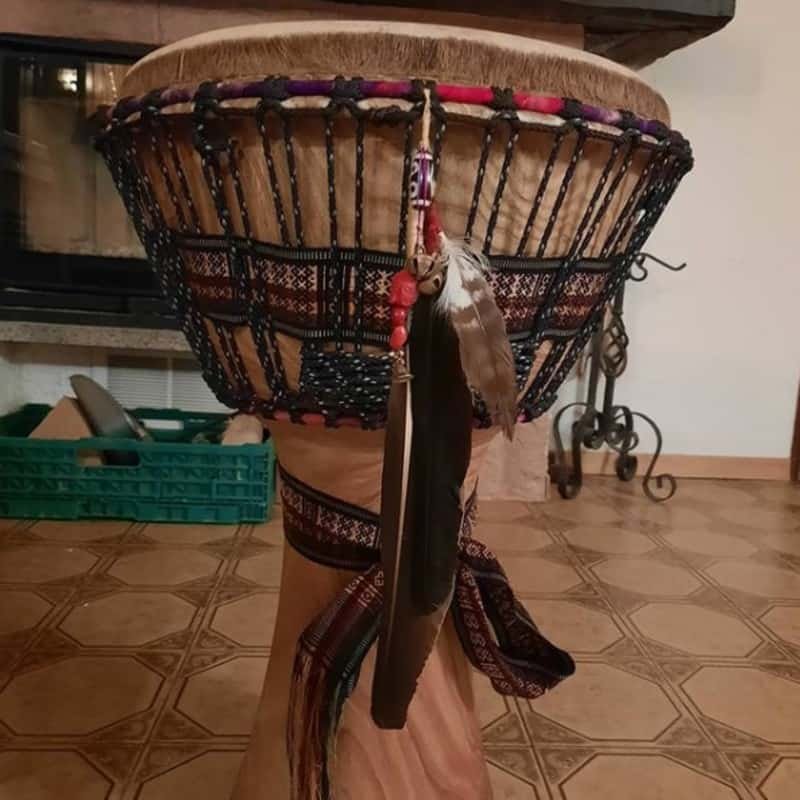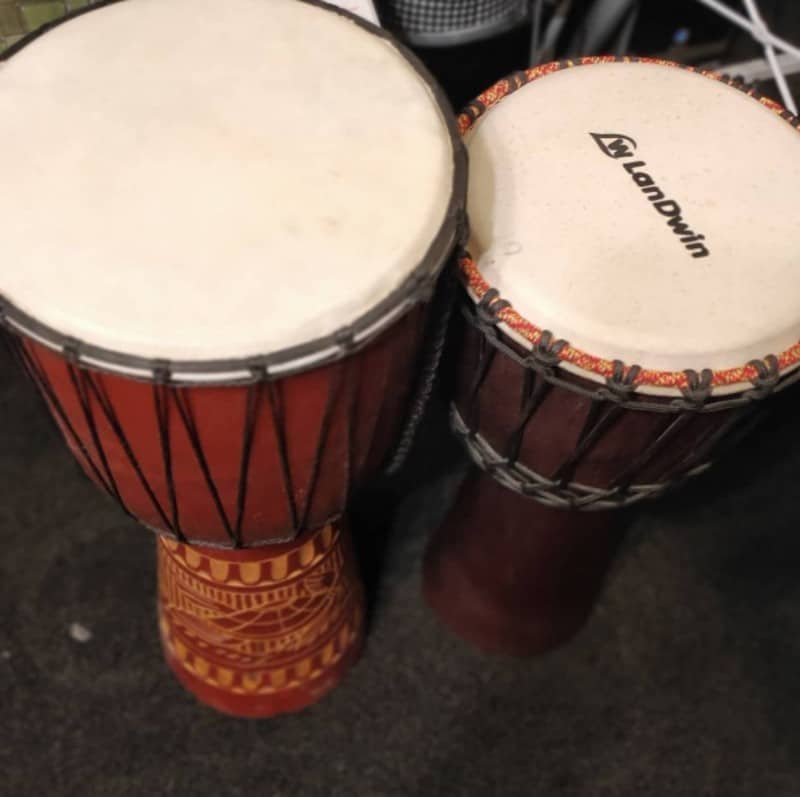
A djembe is an African drum, and, perhaps, it is one of the most popular ethnic instruments nowadays. Playing on it develops a sense of rhythm, and coordination of movements, and has a calming and healing effect. It is most interesting to play the djembe in groups, but you can start mastering this instrument alone. This is what my article is about. From it, you will learn how to play the djembe drum and which professional techniques and tips exist. Even a beginner musician can learn to play this instrument; the main thing is to have a little patience.
Step-by-Step Guide on How to Play African Drum
Contents
Despite the outward simplicity, this drum has a mystical volumetric bass sound, and its rhythm is compared to a heart rhythm. The unique sound of this instrument attracts even scientists. So why not learn how to play it?
What is a djembe?
The djembe is a traditional West African drum that has a distinctive shape and sound. You will definitely not confuse it with any other instrument, thanks to its goblet shape. Traditionally, it is made of a single piece of wood. Its membrane is the skin of a goat, cow, antelope, or zebra (in modern models, manufacturers use synthetic fiber as a substitute). By varying the tension of this membrane, you can adjust the sound of the drum. A distinctive feature of traditional instruments is the presence of decorative patterns and sacred signs on the outside.
Djembe history
The djembe homeland is considered the state of Mali, which appeared and flourished successfully back in the 13th century. Actually, Mali became the point of popularity and spread of the djembe to the entire territory of West Africa. However, in some tribes, scientists found drums similar to it, made as early as 500 AD. These musical instruments were used not only as an accompaniment to special occasions (funerals, hunting, war, and rituals) but also to transmit information by the telegraph principle because the djembe sound can be heard for 5-7 miles.
In European countries, people learned about the djembe in the 50s thanks to the musical ethnic group “Le Ballet Africains.” Their brilliant performances were always accompanied by playing African drums and attracted the listeners’ attention with their originality. Gradually, the djembe drum entered the musical environment of other countries and continents.
How to play djembe?

Undoubtedly, all African percussion sounds unusual and exciting to learn, but I have a special love for the djembe. So, here are some basic steps to help you master this wonderful musical instrument faster.
Step 1: Pose and hand position
Traditionally, in Africa, the djembe is played standing, but it is most often played in European countries while sitting, as it is easier and requires less effort. Sit on the edge of a chair, relax your shoulders, slightly move them to the sides, and do not press or protrude your elbows but keep them somewhat relaxed. Place the djembe between your legs so that its bottom rests on the floor, and the instrument itself is located at a slight angle so that the sound comes out freely from the body. Fix the drum with your feet so that it is secure and does not slip.
The main difficulty lies in coordinating the movements of the hands and fingers. It is worth starting with the simplest strikes, which means your forearms should be parallel to the membrane.
Watch your hands: they can move freely around the elbows, but everything else should be fixed. The back and shoulders should not move at all. Prepare for sore fingers and palms after each session until you get used to the djembe technique.
Step 2: Basic strikes
With the help of various strikes on different parts of a membrane, you can get a fairly wide range of sounds and tonalities. Among the many ways to hit the drums, there are three main ones:
- Bass. It is a sharp but light hit, delivered to the membrane center with the palm of your hand together with your fingers. It can be done with both left and right hands.
- Tone. The next highest strike is performed with the fingers and the upper part of the palm closer to the drum edge.
- Slap. It produces the highest sound. It should be done with your fingers near the very edge of the membrane. The closer to the edge, the higher it will be.
When extracting each sound, it is essential to relax the palms and fingers so that the hand bounces off the surface as if springing. Otherwise, the music will turn out to be dull and weak. Try to train all movements at a slow pace at first, with control of the correct palm position and the work of the hands. Then the strikes can be accelerated, bringing them to automaticity.
Step 3: Control your breathing
Correct breathing is the key to your well-being and endurance. Some pros even recommend doing a little warm-up before starting a session or meditating to focus on playing the instrument. Do not chase speed, and do not try to play only at a fast pace. Alternate between fast and slow rhythms so that you can take a long deep breath with your belly. As you exhale, relax your shoulders and arm muscles to relieve stress and watch your heartbeat.
Step 4: Exercise daily
I recommend looking at tutorials from the pros on making strikes correctly and then moving on to training. You can find simple djembe rhythms and practice them, bringing the movements to automaticity. Learning how to read the score of these drums is not tricky, so you can take popular exercises from the Internet and do them daily, gradually moving from easy to more complex ones.
Among my favorite traditional African rhythms, I would single out Yankadi, Kuku, and Komkoba. These drums are quite versatile, so you can play rumba, bossa nova, reggae, rock, and many oriental rhythms on them.
Step 5: Play in a group and experiment

Once you have mastered the basics of playing African drums, I recommend trying group sessions. Traditionally, several people always play the djembes, and it is an excellent option for beginners as it makes it easier for you to keep to the rhythm. Surely, the team will have someone more experienced than you, and you will adjust to their speed of play. Not only will you master this instrument and learn rudiments faster, but you will also be able to develop creativity by coming up with your own rhythms.
Some musicians improve the sound of these drums by attaching kessings (snares) to them. It is an auxiliary instrument in the form of a leaf-shaped aluminum plate with many small metal rings, which emit a “rustling” sound when moved. Also, after you have fully mastered the basic hits, you can try to extract the sound from the drums with light fist strokes or rub the membrane with your palm. Do not limit your imagination and let your creativity run wild.
FAQ on Playing Djembe
It is not surprising that such an unusual instrument as African drums generates so much interest among music lovers. Here are a few basic questions and answers to them.
How do you play the djembe?
The djembe is usually played while sitting or standing (the latter is traditional) with hands without drumsticks or mallets. Position the drum between your legs to be at an angle to your body and not sit flat on the ground (you should completely block the bottom). Place your hands and wrists parallel to the membrane, and lightly press your elbows against the body. Now, start training by combining the beats on the center and sides of the drums.
Is djembe hard to learn?
A huge advantage of the djembe is the lack of musical notation. You don’t have to study long to learn how to read patterns and rhythm schemes. However, you will have to tinker with the technique. The main pain of aspiring musicians is learning how to play the tone and slap easily and clearly. Most often, both strikes sound the same, without significant differences. Watch videos of how the pros do them to understand the difference in technique.
What are the three main djembe playing techniques?
The three fundamental drum strikes that underlie any rhythm are bass, tone, and slap. The closer to the center of the membrane you hit, the lower the sound produced. So, for example, for bass, you need to strike the very drum center with your palm and fingers together. Try to hit as fast as possible so that the hand quickly bounces off the surface. Once you have mastered the basic techniques, you can modify them. For example, hit the membrane with the palm of your hand and your fingers outstretched. It will give a completely different sound.
Practice to Get the Right Sound
I hope my guide will help you master this amazing instrument in a short time. As you can see, learning djembe is not as difficult as, for example, an entire drum kit. By and large, with due diligence, you can learn the basics in 8-10 hours and then improve your technique and invent your own rhythms. It has been proven that playing these drums has a healing effect, in particular, a meditative, relaxing impact on the nervous system.
Do you have an exciting story about djembe drums? Please write it in the comments; I’ll be glad to read it.

